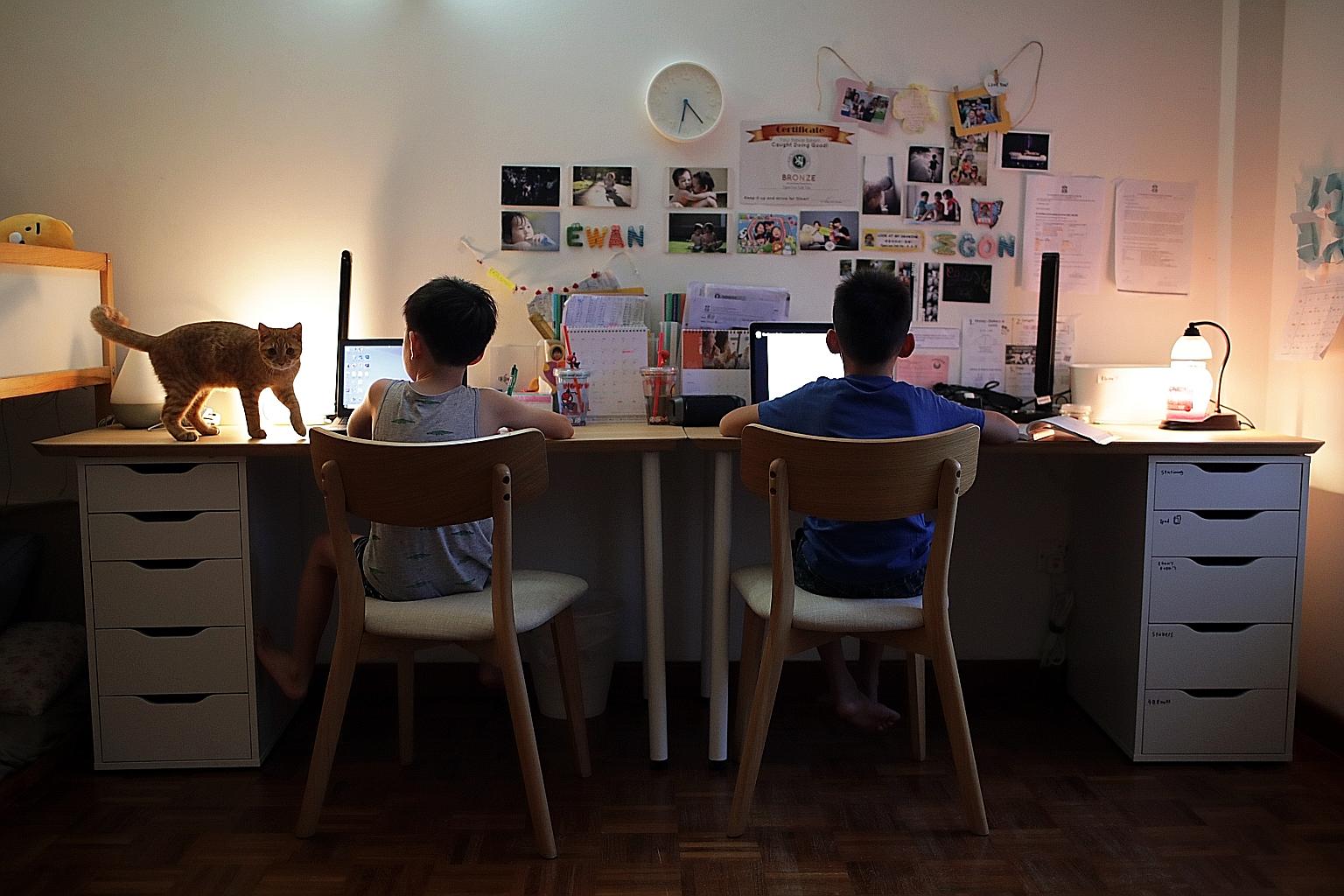Among the e-mails and text messages from parents talking about the difficulties and frustration they are facing with home-based learning, one parent, Mrs Margaret Teoh, asked how she should make the most of this time that she is spending with her children.
Mrs Teoh, a mother of two primary school-going children, said she too faced many difficulties trying to juggle her work as a finance manager with supervising her children's learning at home.
But being "a glass half-full" kind of person, she also saw the coming month as an opportunity for her and her businessman husband to bond with their eight-year-old son in Primary 2 and 11-year-old daughter in Primary 5.
While many parents were worried about learning loss, she asked for advice on how she can seize this opportunity to help her children learn more.
I delved into the research on online learning and spoke to some expert teachers and education psychologists on how parents can help their children make gains during this period of home-based learning.
First, one piece of common advice from all the experts is to start by creating a schedule for the week and get your children involved in the process.
Most schools would have given a timetable for the online lessons and assigned work that children have to complete. Incorporate that into the schedule you draw up with your children. Consistency and structure is important because children learn more easily when they know what to expect.
A schedule also allows parents and other caregivers, whether it is the maid or grandparents, to share some of the duties. Make sure to build in breaks, a range of activities and some choices - for example, to read their favourite book or to piece together a puzzle.
Take into account the attention span of children. Most younger children can work on assignments for around 25 minutes to half an hour before they need a break.
Use a timer to arrange breaks and to transition to new tasks.
In between, have children learn some new dance moves, get a drink of water, take a short walk, climb stairs or play a game. It will be tempting to give in to their pleas to play an online game or watch a video - but this should come at the end of the day. These make good rewards, but can be distracting midday.

If you have young children, give clear instructions as they move from one activity to another. Make sure you face your children and have eye contact before giving verbal instructions. After you are done, ask them to restate the main points you have made.
Don't confine learning to the work assigned by their teachers. There are numerous online platforms that offer lessons (both free and paid for), activities, quizzes and so on.
Among the platforms that I have used for my own learning is the one by Khan Academy, which offers free lessons in maths, science and humanities from kindergarten level to the early years of college. Students can use the exercises, quizzes and instructional videos to learn and master skills.
Another one I would recommend is Outschool, referred to as the "Netflix for learning". It offers live classes, at a small cost, for young people between the ages of three and 18. Some of the lessons I have sampled are taught by expert teachers who are passionate about the subjects they are teaching. There are lessons ranging from chemistry to architecture, and they combine learning with play - architecture is taught with Minecraft.

Research suggests that writing by hand creates stronger memories and understanding, so try to include written assignments along with online options.
A couple of teachers also suggest project-based learning, which is a powerful way of learning.
Help your child to identify a project they can explore deeply and without too much guidance or adult support. Even though families have been advised to put off their mid-year holiday plans, perhaps you can ask your children to do some research and create a travel plan and budget for a new destination.
One innovative parent I know has asked her Secondary 4 daughter, who is interested in cooking, to help her grandmother create a cookbook with favourite family recipes. Her 14-year-old son, who is an avid photographer, has been roped in to take pictures of the various dishes.
A veteran primary school teacher has suggested getting children involved in drawing up a grocery list. Depending on the child's age, elements of mathematics could be incorporated, by getting them to estimate prices and weights. Children can also work out which option is better value for money, such as between a small and large packet of rice.
Older children and teens can be encouraged to explore their interests which they don't have time for during the school year. Learning at home can offer them a chance to dig deeply into a subject of their own choosing, from baking cupcakes to urban vegetable farming to how to design a simple video game.
And if you are interested in the subject, you can learn along with your child. This is a great time to be a role model by being curious and showing them how to learn.
One parent recounted to me a story on how homeschooling her daughter for five weeks due to a leg fracture allowed the then Secondary 1 girl to delve deeper into understanding how doctors fix bone fractures. She subsequently developed an interest in biomedical science and, now in junior college, she hopes to further her interest in the field in university.
Another veteran teacher pressed on me the point that this coronavirus pandemic is a once-in-a-lifetime opportunity to learn all kinds of subjects. Her suggestions include teaching kids how to make soap and asking them to look into how soap can kill the coronavirus. There is also the other pandemics, like the Spanish flu, and how viruses are named. The children will have real, powerful lessons in geography when they examine the patterns of Covid-19 spread.
Go online to look at numerous other learning ideas.
But the most important thing in the next month or two is not keeping up with a prescribed curriculum, but keeping children engaged with learning and the idea of learning. At the end of the day, when the school work is done, it is an opportunity to call a timeout on the academic rat race and pursuit of grades.
Take time to do fun things with your children - bake cakes, make cookies and hold a contest to see who can make the best chocolate cookies. Play board games, watch scary movies and go for walks in the neighbourhood or nearby parks. Remind your children how lucky they are and make them aware of the difficulties faced by classmates who come from disadvantaged homes. Ask them if doing a grocery run for the families of their needy classmates will help.
These are worrying times indeed. But you can also use the time to make happy memories with your children that they will never forget.











